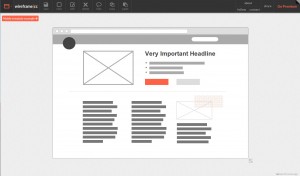 When designing desktop apps, websites, and mobile applications, more than once I have tried using an application like mockingbird or Pencil Project. On one hand, mockingbird, is a web application that can be accessed from any browser and allows you to design multiple pages with different elements. On the other hand, Pencil Project, initially born as a Firefox extension, now has a multiplatform desktop application that allows you to mockup easily.
When designing desktop apps, websites, and mobile applications, more than once I have tried using an application like mockingbird or Pencil Project. On one hand, mockingbird, is a web application that can be accessed from any browser and allows you to design multiple pages with different elements. On the other hand, Pencil Project, initially born as a Firefox extension, now has a multiplatform desktop application that allows you to mockup easily.
The drawback I see on these two applications is that for some reason, I always end up making simple mockups with a simple pen and paper. This way I can organize my ideas faster than using these applications. I guess the main reason for this is that I’m not a designer, so to me it is the same doing a shitty design in paper, than a shitty design with an application. Moreover, usually using a computer app for this task I end up spending more time to do the same…
Anyway, the other day I discovered Wireframe.cc, and the truth is that I was quite impressed by the UI. It is super-easy and fast to use. You just drag the mouse while clicking and voila, you have an item of the size of your selection. You click on the type of item you want and you are done with the item. Even if you want to change attributes, you just have to double click on it, and select the attributes you want to change.
Actually, it is the first time I feel that I do not waste my time doing mockups with an application of this kind. From what I’ve seen, this application is starting, and it still lacks of some functionalities and needs some polishment, but I suppose that those will be added in the future. Even I think this lack of complexity and lack of tons of box types is what makes you go faster.
I think choosing the right tool for a job is a matter of personal preferences and personal needs, but I would recommend trying wireframe.cc and taking a look at the other apps I pointed out at the beginning of the post.
Feel free to share any other tool you find useful in the comments 😉
 Español
Español
03/03/2009 at 12:36 am Permalink
Jajaja me encanta el nombre del artículo, sobre todo porque en más de una ocasión yo mismo he pensando aquello de “I just give up, i’ll use a table”
26/03/2009 at 7:29 am Permalink
Creo que el pensar así te hace un flaco favor… evidencia que no conoces la maquetación con CSS y estándares. No es solo que quede bien en todos los navegadores, luego está el mantenimiento y escalabilidad del código HTML que generas, por no hablar del código XHTML que te ahorras o las posibilidades de interacción de elementos que no son tablas con javascript. Llevo más de 10 años maquetando páginas web, y si bien reconozco que hay que hacer un esfuerzo para cambiar el chip de tablas a CSS, también sé que esta última forma de maquetar solo presenta ventajas frente a las tablas. Utiliza tablas para matrices de datos, como listados de precios, tablas comparativas,… pero el resto de tags tienen su función semántica perfectamente definida. No todo son DIVs, hay Hs, SPANs, Ps, ULs y OLs, SUPs,… Si tienes problemas para maquetar con CSSs, te recomiendo que te descargues un framework, que te facilitará el trabajo en gran medida. Un saludo!
27/03/2009 at 11:49 am Permalink
Hola Tolo.
Como decía originalmente, usar DIVs para todo está mal. Este ha sido mi error.
Estoy de acuerdo contigo en que las tablas deben utilizarse para mostrar listados de datos, pero también tienen usos que simplifican tanto el tiempo de desarrollo como el tiempo de mantenimiento.
El ejemplo más claro que veo, es cuando uno diseña el layout de la página. Si uno emplea DIVS u otros tags, hay que hacer MUCHOS hacks para hacer algo que de forma natural surge con una tabla.
Metafóricamente hablando, el problema de todo esto, viene cuando uno (en este caso era yo mismo) intenta calzarse unos zapatos que no le vienen (usar DIVs), da igual que el calzador sea muy bueno (hacks varios), que el pie no va a entrar, y si entra (al final, despues de varios hacks la cosa funciona) va a ser peor el remedio que la enfermedad, hubiera sido mejor tirar esos zapatos desde un principio y ponerse otros (tablas).
Tablas sí, divs también! Calzadores no!